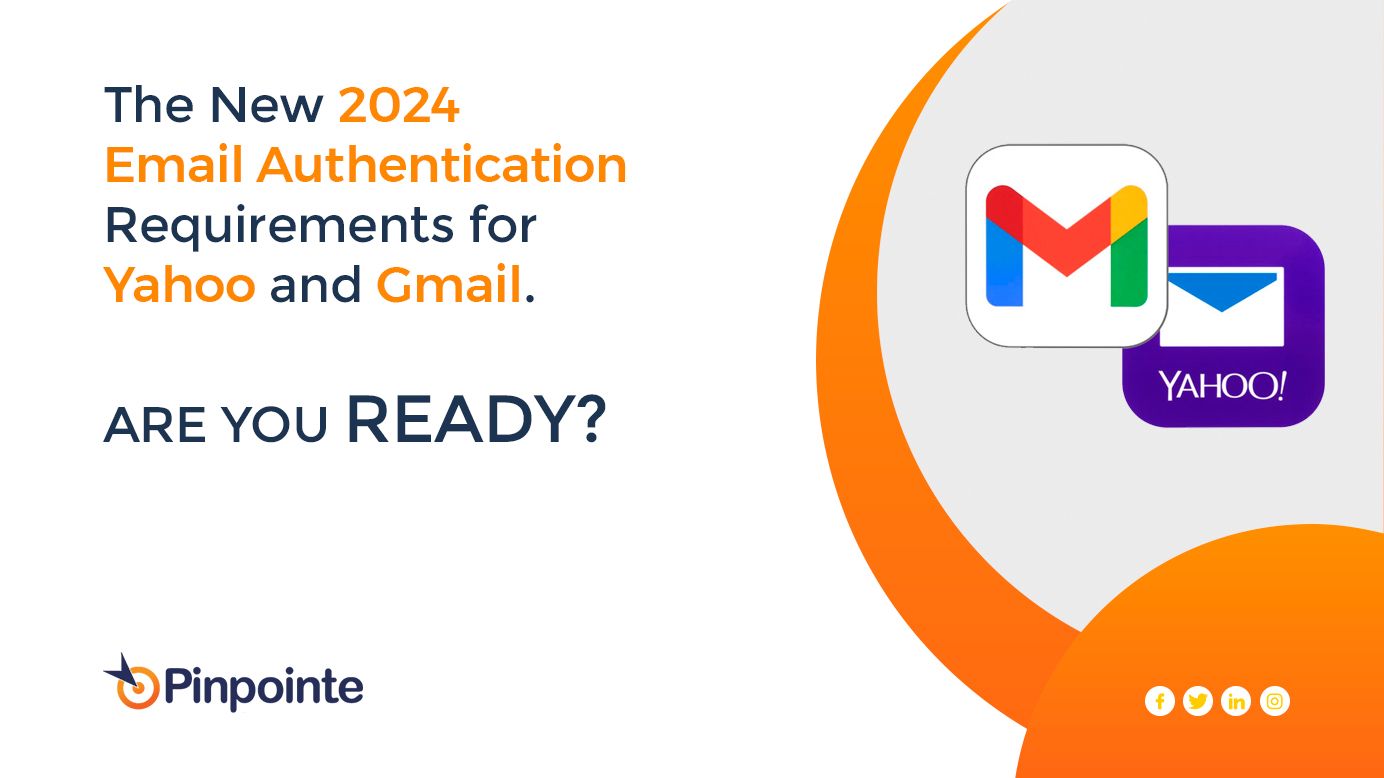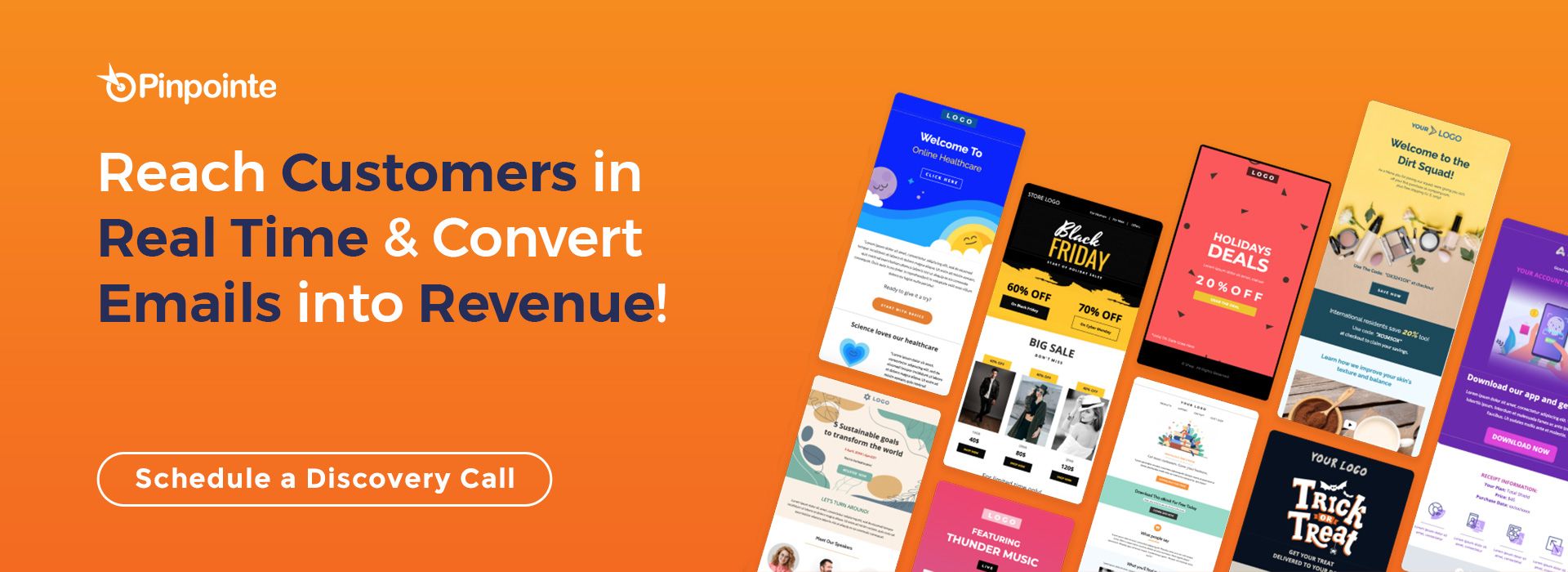
The New 2024 Email Authentication Requirements for Yahoo and Gmail: Are you Ready?
Table of Contents
In an era where email security is under constant siege from cyber threats the ever-growing influx of spam, major inbox providers such as Gmail and Yahoo have introduced formidable guidelines. These measures mark a crucial turning point in fortifying the security of email—a cornerstone of global personal and business communication. But why are Google and Yahoo implementing these changes, and what impact might they have on you as a sender?
"Every day witnesses the dispatch of an estimated 347.3 billion emails globally, with approximately 3.4 billion falling into the spam category."
It's noteworthy that Gmail's AI defenses thwart a staggering 15 billion unwanted emails daily and successfully block over 99.9% of spam, phishing attempts, and malware. Despite this, Google's recent announcement shed light on the escalating complexity of contemporary cyber threats, prompting the introduction of new guidelines for bulk email senders (those dispatching over 5000 emails to Gmail addresses daily) to bolster email security. Yahoo swiftly followed suit with its own updated requirements for bulk senders, slated to take effect by February 2024.
See the volume of emails and with that kind of number, you just can’t take 2024 lightly with the undeniable regulations coming from Gmail and Yahoo. Just imagine a colossal train hurtling down the tracks at breakneck speed, this isn't just a train; it's a force of nature, and you, find yourself in its path. The reality is stark—you need strong preparation, aligning yourself with an Email Service Provider (ESP) that not only recognizes the importance of these regulations but possesses the expertise to navigate you through it.
Marcel Becker, Sr. Director of Product at Yahoo, emphasized, "Ensuring the safest, most secure email experience is a collective responsibility. Yahoo eagerly collaborates with Google and the email community to establish these pragmatic, high-impact changes as the industry standard."
Both companies underscore the pivotal role of sender validation as a
critical component of email security. The updated guidelines not only
authenticate the identity of senders but also streamline the unsubscribe
process for users, curbing the influx of unwanted emails in their inboxes. The
objective is to address the oversight where many bulk email senders
inadvertently neglect to fortify their email systems adequately, unwittingly
creating a vulnerable pathway for cyber threats to breach defenses undetected.
In the looming shadow of February 2024, failing to adhere to these
directives is not an option; it's a firm guarantee that all emails to Yahoo and
Gmail will be summarily blocked. The urgency cannot be overstated – the
time to act is now.
Understanding the Shift: Why Google and Yahoo Are Making These Changings
Gmail and Yahoo's recent initiatives extend beyond inconveniencing senders; they form a proactive stance to create a safer online environment amid the escalating tide of cyber threats. With phishing, spam, and other online attacks comprising a staggering 91% of threats, these email giants are taking pivotal steps to secure user inboxes. This push for heightened security isn't confined to Gmail and Yahoo; it signals an imminent industry-wide shift toward robust email security standards, paving the way for other major providers to follow suit. For senders, these changes bring substantial implications, ushering in a fundamental shift in the management of email authentication and formatting. The focus on combatting impersonation and ensuring secure, well-structured emails impacts senders across different email volume thresholds.
To adapt to these changes, senders need to take proactive steps well in advance. Understanding the new rules, gauging their impact on specific sending volumes, and aligning practices with these guidelines is crucial. Proactive adjustments in email authentication and formatting practices are necessary to comply with these firm regulations. These distinct requirements aim to strengthen email authentication, ensure proper formatting, and prevent impersonation, catering to senders operating at different email volume thresholds. The details of these thresholds are outlined below.
Failure to comply with regulations put your emails to Yahoo and Gmail at risk of being blocked starting in February. Even reputable senders with outstanding reputations face the inadvertent risk of being ensnared if they do not take proactive measures to address this immediately.
The details of different thresholds are mentioned below;

Requirements for Senders <5,000 per day
- SPF (authorization) AND DKIM (authentication) are both required.
- Ensure valid forward and reverse DNS records
- Ensure that the spam rates reported in Google's Postmaster Tools are below 0.1%, and keep spam complaints (commonly known as 'fbls') reported by yahoo.com under 0.1%.
- Must be a properly formatted message (In technical terms, must adhere to RFC 5322 standard which any viable email provider does).
- DKIM must align with the 'Send-From' email address - i.e., the domain of the email address that you see in your inbox.
- Ensure valid forward and reverse DNS records for all IPs and servers that will be sending email.
- Don't impersonate gmail.com FROM hearers. What this means is ' don't send from an address like someone@gmail.com. Many ESPs already forbid doing this when sending campaigns in volume because it causes delivery problems.
Requirements for Senders >5,000 per day
- SPF (authorization) AND DKIM (authentication) are both required.
- Ensure valid forward and reverse DNS records.
- Ensure that the spam rates reported in Google's Postmaster Tools are below 0.1%, and keep spam complaints (commonly known as 'fbls') reported by yahoo.com under 0.1%.
- Must be a properly formatted message (In technical terms, must adhere to RFC 5322 standard which any viable email provider does).
- DKIM must align with the 'Send-From' email address - i.e., the domain of the email address that you see in your inbox.
- Properly aligned and passing DMARC email authentication for your sending domains.
- From: header must be aligned with either the SPF domain or the DKIM domain.
- Ensure valid forward and reverse DNS records for all IPs and servers that will be sending email.
- Must have a 'properly aligned' DMARC Entry for your sending domain.
- One-click unsubscribe header for subscribed messages.
- Don't impersonate gmail.com FROM hearers. What this means is ' don't send from an address like someone@gmail.com. Many ESPs already forbid doing this when sending campaigns in volume because it causes delivery problems.
The impending deadline for compliance underscores the urgency for senders to adhere to these new directives, emphasizing the significance of email security and user convenience in the digital landscape.
Impact on Bulk Email Senders
These requirements aren't exclusive to Gmail and Yahoo users; built upon open standards, these measures are poised to benefit the broader spectrum of email recipients, regardless of their email service providers. With Google and Yahoo's proactive approach in fortifying email security and enhancing user experience, these requirements herald a fundamental shift that spans well beyond their ecosystem.
Furthermore, the extensive user base served by these two giant’s marks a significant focal point for these changes. The criticality of this impact is notable for all senders and they need to fix this as soon as possible to align with these new regulations and requirements in advance or they will see themselves get blocked by the Gmail and Yahoo as the implementation gets done in February 2024, so don’t wait and start now.
Delving into the Three Email Security Requirements
Enable Email Authentication
The foundation of these changes is in implementing SPF, DKIM, and DMARC, now mandatory for email authentication. Adhering to these protocols significantly reduces fraudulent and malicious emails, protecting inbox security by selective and intercepting potential threats, as emphasized by Google and Yahoo for building trust in email delivery.
- Sender policy framework (SPF) serves as a security mechanism that serves to prevent unauthorized users from sending messages from your domain. By defining a list of authorized sending mail servers and IP addresses for a specific domain, SPF helps recipient servers verify whether incoming emails originate from an authorized source or not. This assists in curbing email forgery and significantly contributes to enhancing email security by thwarting unauthorized entities attempting to impersonate your domain in emails.
- Domain keys identified mail (DKIM) provides an additional layer of authentication by using cryptographic signatures to verify the legitimacy of email messages. DKIM allows recipient servers to validate whether the message received from your domain indeed originates from your organization. If you are sending via an email provider, your emails will now usually be 'signed' with two keys: One will be from the ESP (example @amazonses.com if you use Amazon SES), and must also be properly signed with your send-from domain (example, @yourcompany.com). This helps establish trust in the source of the email, ensuring its authenticity and integrity, consequently fortifying the email ecosystem against spoofing and tampering attempts.
- Domain message authentication reporting (DMARC) Adding a DMARC record that passes, is a new and a must follow requirement, so even if a customer already has both SPF and DKIM they still need to also add a proper DMARC entry. This allows senders to specify the actions to be taken on messages that do not meet the prescribed authentication standards. DMARC policy empowers senders to set policies for email handling, like whether to deliver, quarantine, or reject emails that fail the validation tests, thereby significantly augmenting the control and security of email correspondence.
Making Unsubscribing Effortless for Users
Google and Yahoo are mandating an effortless, one-click unsubscribe option for all email senders which is in header. The emphasis on this requirement stems from the shared belief that subscribers should have a hassle-free and swift method to opt out from email lists. This aligns with user-centric principles, fostering a smoother experience for individuals wishing to disengage from various email subscriptions.
“We’re requiring that large senders give Gmail recipients the ability to unsubscribe from commercial email in one click,” Google notes, with Yahoo backing the rule in its blog post.”
For Pinpointe users, no additional action is required in adhering to this timeframe. As long as the newsletters contain a clearly visible unsubscribe link, users are compliant with this specific policy. The alignment between these industry-mandated policies and Pinpointe's existing approach emphasizes the platform's commitment to facilitating a seamless and efficient experience for both senders and recipients in managing email subscriptions.
Reducing Spam Complaints
The significance of this final requirement stands out prominently among the rest. It focuses on the influx of irrelevant or unwanted messages by introducing a threshold for spam rates. While it may seem like a small addition, the reason it's crucial is that, until now, Gmail's email sender guidelines advised keeping spam complaints below 0.1% (with a permissible ceiling of 0.3% for a short duration), yet it was merely a recommendation often disregarded by numerous senders.
However, in February 2024, this recommendation will transition into an mandatory requirement. This shift signifies that maintaining a low spam complaint rate will no longer be discretionary but mandated. Therefore, initiating compliance measures now becomes imperative if you aim to ensure the delivery of your messages to recipients' inboxes.
For more detailed insights into these requirements, you can explore Google's guidelines applicable to all senders and the additional criteria set for those sending 5,000 or more messages daily. Familiarizing yourself with these regulations and aligning with them promptly is crucial for maintaining effective communication practices and ensuring that your emails reach their intended destinations successfully.
Benefits of Gmail and Yahoo Compliance and Steps for Bulk Email Senders
Compliance with Google and Yahoo's stringent email authentication standards offers a range of substantial benefits while also presenting anticipated challenges. Adherence to these requirements has the potential to enhance the inbox placement of reputable senders, making it more likely for their emails to land directly in recipients' inboxes rather than being relegated to spam or promotional folders. This improved placement ensures that vital communications and marketing messages receive the attention they deserve, fostering a more direct and impactful connection between the sender and the recipient.
Moreover, abiding by these stringent standards contributes significantly to upholding a domain's reputation. By implementing robust email authentication practices such as SPF, DKIM, and DMARC, organizations mitigate the risk of bad actors attempting to impersonate or spoof their domain. This proactive approach bolsters the security and credibility of the sender's domain, thereby fostering a safer and more trustworthy email ecosystem for both senders and recipients. It's a step towards fortifying the integrity and reliability of email communications, assuring users that the messages they receive are authentic and from genuine sources.
To align with these action steps, bulk email senders must take decisive steps in fortifying their email security protocols. Essential actions include the implementation of SPF (Sender Policy Framework), DKIM (Domain Keys Identified Mail), and the incorporation of a DMARC (Domain-based Message Authentication, Reporting, and Conformance) record. These measures not only meet the current standards but also enhance the overall security of email correspondence, minimizing the chances of unauthorized activities and elevating the trustworthiness of sender domains. Implementing these protocols is a proactive approach to not only meet Google's security requirements but also to fortify the credibility and security of your email communications.
What Happens If You Miss the Deadline?
Missing the deadline for implementing email authentication can have severe consequences for your company's email deliverability, particularly when communicating with Gmail and Yahoo users. Failure to comply with these changes, especially for senders dispatching over 5,000 emails daily to these accounts without proper SPF and DKIM or without a DMARC policy, will significantly hamper your message deliveries, leading to substantial repercussions for your business.
How Pinpointe Can Help?
Facing the Email Verification Challenge
For customers without extensive IT resources, our email verification process simplifies the authentication journey. Even without a DKIM key for the send-from address, Pinpointe ensures a single-signed email with a DKIM key for the sender. Combined with a correct SPF record, this method overcomes challenges, providing a viable solution for those with limited technical capabilities.
Expertise, Guidance, and Seamless Onboarding
Unlock the full potential of your email campaigns with Pinpointe's unparalleled delivery expertise, comprehensive resources, and extensive experience. Our dedicated support team is equipped to assess your current status and bridge any gaps more effectively and efficiently than if you were to navigate this journey alone.
Benefit from our extensive track record—having sent tens of billions of emails and executed hundreds of thousands of campaigns. Leverage our expert support team to review your campaigns, ensuring optimal setup. As our support is free, feel free to reach out anytime for an account or campaign settings review, providing an added layer of assurance.
Pinpointe Infrastructure: A Foundation for Your Success
Our robust systems are strategically designed to enhance your email delivery experience. We seamlessly add DKIM key signing, process 1-click unsubscribes, and efficiently manage feedback loop complaints from recipients, all aimed at improving your inbox placement.
The security of your emails is our priority. We utilize the latest TLS for
secure transit, ensuring that your messages are transmitted securely, and we
adapt our sending strategy to each inbox provider, optimizing speed while
respecting their individual throttling preferences.
Before you embark on sending campaigns, our support team conducts a thorough pre-flight check. This includes a meticulous review of your setup, providing precise DNS entries for SPF, DKIM, and DMARC. We actively verify that these configurations are correct, allowing you to send your campaigns with confidence.
Pick Your Sending Infrastructure
Pinpointe's updated email routing feature offers you the flexibility to choose your sending infrastructure. Whether you prefer Pinpointe's IP pools or opt for services like Mailgun, Amazon SES, or SparkPost, our platform adapts to your needs seamlessly.
Pinpointe Pre-flight Check: Ensuring Smooth Campaigns
As a final step, our pre-flight check goes beyond security settings. We verify and report on various elements influencing inbox placement and long-term reputation, including link integrity, image quality, content length, and the proper use of secure HTTPS links. With Pinpointe, your email campaigns are set for success from the outset.

Schedule a Discovery Call with Pinpointe

Pinpointe Newsletter
Join the newsletter to receive the latest updates in your inbox.

